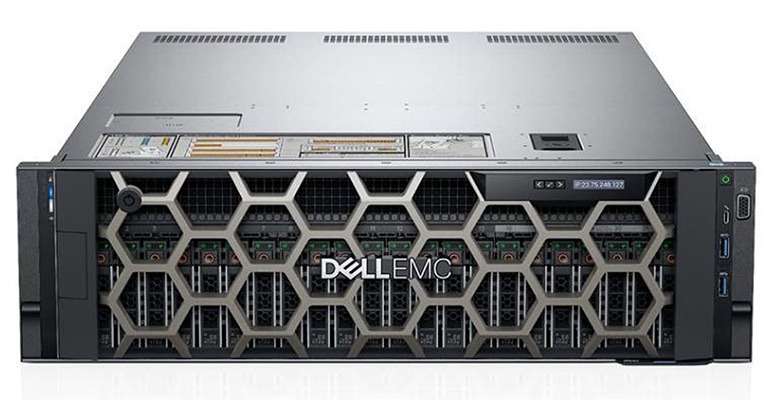Dell EMC's PowerEdge MX modular architecture is designed to take customers from the present to the future.
August 21, 2018

First came the sneak peek at Dell Technologies World in May, and on Tuesday, Dell EMC formally announced its PowerEdge MX, a modular architecture designed to bridge the demands of existing traditional and transformational workloads.
There are three key elements of PowerEdge MX: its modular architecture bringing together compute, storage and networking; what the vendor calls a kinetic infrastructure — a design for a memory-centric and composable world; and OpenManage Enterprise – Modular Edition for comprehensive in-system management.
“The challenge that organizations have going forward is, how do you make sure that you have a chance to run your workloads of today and your workloads of the future? And that’s where PowerEdge MX comes in and provides a platform to run various workloads in a single infrastructure,” said Ravi Pendekanti, senior vice president, product management and marketing for server and infrastructure systems at Dell EMC. Workloads of the future are things like IoT, artificial intelligence and machine learning, for example.

Ravi Pendekanti
Ravi Pendekanti
The notion of a kinetic infrastructure is based on designing for a memory-centric, composable world — or an infrastructure design that’s adaptable to both expected and unknown technology changes as they come down the pike. That means giving customers a future-ready, right-sized and cost-efficient IT architecture.
The imperative to help organizations with their IT transformation initiatives is critical, according to Pendekanti, who cites a recent Dell EMC sponsored white paper by ESG Research that found more than four in five (81 percent) businesses agree that if they don’t embrace IT transformation, they’ll lose their competitive edge in their market. In other words, change or be left behind.
A big thrust behind Dell EMC’s new infrastructure technology is doing away with costly rip-and-replace upgrades; overprovisioned and underutilized resources; and inefficient management processes, with the goal of improving the total cost of ownership for customer investments, while insuring that businesses have a single, flexible infrastructure for their multiple workloads — at the right price.
Dell EMC OpenManage Enterprise Systems Management is a single console used to manage all PowerEdge devices.
“This is an infrastructure-management tool that utilizes industry standard APIs to plug into other consoles that customers use to manage other IT infrastructure, whether that’s in an emerging DevOps world using Redfish commands, or more traditional tools that exist in a data-center environment such as Microsoft System Center or VMware vCenter,” said Brian Payne, vice president, product management and marketing, for Dell EMC PowerEdge.
The Modular Edition manages the PowerEdge MX infrastructure components from deployment to updating and monitoring, and is delivered within the MX system.
Dell EMC PowerEdge MX product general availability is Sept. 12. At launch, the company will deliver 2 socket and 4 socket compute sleds, which represent the sweet spot for today’s existing and emerging workloads, according to Payne.
Each compute sled, or multiple compute sleds, has integrated direct-attached SAS storage. The vendor offers an array of networking devices that are able to connect into an Ethernet environment and a fibre channel environment. The chassis is a 7U modular enclosure.
The PowerEdge MX offers a portfolio of components for design flexibility:
Dell EMC PowerEdge MX7000 chassis — Offers a hardware foundation with support for multiple server processor generations, in a scalable system with end-to-end life-cycle management and a single interface for all components. This 7U chassis includes eight bays to accommodate a variety of full- and double-width compute and storage combinations.
Dell EMC PowerEdge MX740c and MX840c compute sleds — Two- and four-socket blade sleds deliver full-featured, no compromise compute, with exceptional performance and a rich set of storage options including NVMe drives, the company said. The full-width MX740c and double-width MX840c support the full Intel Xeon Scalable Processor family with up to six terabytes of memory. The MX740c can house up to six 2.5” NVMe, SAS or SATA drive bays, and the MX840c can hold up to eight.
Dell EMC PowerEdge MX5016s storage sled — Dense, full-width, scale-out storage sleds complement MX servers, holding up to 16 hot-pluggable SAS storage hard disk drives, with a maximum of seven MX5016s sleds in the MX chassis for up to 112 drives of direct-attached storage. These drives can be individually mapped to one or more servers, offering the ideal storage ratio needed for specific use cases.
Dell EMC PowerEdge MX Ethernet and Fibre Channel switching modules — These new low latency, high-bandwidth switching modules for multi-chassis environments include automated processes for topology compliance, quality of service and autonomous healing for peak network performance with the PowerEdge MX single management interface. PowerEdge MX is the industry’s first modular infrastructure to deliver end-to-end 25GbE and 32Gbps fibre channel host connectivity. Combined with 100GbE and 32G fibre channel uplinks, customers can expect up to a 55 percent reduction in switching latency for highly scalable, multi-chassis fabric architectures.
“We made a couple of very deliberate design decisions as we approached the network space which was that we wanted to support a high amount of bandwidth between nodes, so we decided to go with 25Gb Ethernet as the standard for all of our switching infrastructure on the Ethernet side from Day 1,” explained Drew Schulke, vice president, product management for Dell EMC networking. “We also wanted to have the ability to deploy large deployments of MX where we didn’t have to go with the traditional model and embed a switch into every single chassis.”
To meet that later objective, the MX scalable fabric supports a switching edge that allows Dell EMC to bring a total of 10 chassis together under a single switching infrastructure with low latency of the overall network.
Dell EMC’s Pendekanti wants partners and customers understand what differentiates the new MX architecture from existing Dell EMC hyperconverged offers such as VxRail and the XC Series with Nutanix. The latter solutions target single workloads, whereas DX composable architecture can run multiple workloads.
“Beyond the workloads, if you want to have an architecture that goes into supporting GPUs (graphical processing units) and FPGA’s (field programmable gate arrays) in the future, the PowerEdge MX has that flexibility,” he said.
The vendor plans to continue its partnership with Nutanix, living up to its goal of offering customers platforms that support different software.
Dell EMC partner enablement and support are already underway, including training on how to leverage the PowerEdge DX, Pendekanti said.
About the Author(s)
You May Also Like


